Borders, guards and angry tourists

Organised chaos...sort of.
Having spent a week on Koh Chang staring at the sunset, sitting on a beach and listening to crap music whether we wanted to or not, we decided to make our move and head to Cambodia. The stroll across the border at Had Lek/Cham Yeam is up there as one the most memorable I’ve had. Our bus dropped us at the Had Lek (Thai side) checkpoint where our passports were stamped by the Thai officials and we were moved along. Total time: 20 seconds.
After a short walk across no-man’s land we arrived at Cambodian passport control (Cham Yeam). What happened next was one of the funniest (for us) spectacles we’ve seen so far in asia. Whereas the Thai border is perfunctory and efficient, the Cambodian side is anything but. My first piece of advice if you want to cross into Cambodia via land is have an e-visa ready to go. We were warned about the white shirted touts who look officious and important...but don’t actually work for the border police, but still narrowly avoided having our passports taken away by one. He was pretty disappointed when we cheerfully waved our e-visa paperwork at him and walked off. You can buy a visa at the point of entry but whether you pay $30 or $50+ depends entirely on how much the Cambodians think they can get away with. If you dodge the touts and go straight to the lines where the locals are queuing, you’ll be fine.
That said, if like us you’re unlucky enough to get a guy on his training day, things might take a bit longer. Despite having our e-visas and entry cards ready, the poor bloke behind the counter kept having to ask his supervisor for help. He also stamped our passports about half a dozen times each. As my wife said it was a bit like watching a 5 year old play with ink and a stamp for the first time. Once he’d finished, it was time for our fingerprints and photos to be taken which was actually fine; the last time I’d checked we didn’t have any criminal convictions or official warnings on our passports or records. About 20 minutes (and stamps) later we were through.
Except that we weren’t.
The sleepy crossing guard sitting under his sun shade sent Jess back to the trainee. Turns out that despite his enthusiasm for stamping everything in sight, he had forgotten to stamp a part of the e-visa that needed to be stamped on Jess’s paperwork. 10 minutes later, she was back and we were officially allowed to enter Cambodia. Except now we had to wait for the rest of our bus to get through the border. And they hadn’t purchased e-visas in advance.
There was a lot of swearing and cries of ‘Bandits!’ floating in the air as we waited. Our fellow travellers basically had to pay whatever the border police decided they had to pay on the day. Some got through for $38, others were charged $48 to $50. Whilst this was happening several Cambodian bus drivers were running around trying to assist and move things along so they could actually get everyone onto the right buses and try and keep their schedules. The whole thing was a bit like watching a live improv comedy show where everything that could go wrong, was going wrong. Eventually we were joined in the 35 degree heat by some of our increasingly hot tempered travellers and made it onto a bus. We were in Cambodia!
Although next time I’d probably spend a bit more money and fly in.
The Rules of the Road - UK
Many countries have different versions of a Highway Code for motorists to follow. Generally designed to prevent people from travelling at dangerous speeds and killing each other, they’re mostly only read when we’re trying to pass our driving test. Once we’ve passed the test we cheerfully flog our copy of the Highway Code on eBay before revving our engines and speeding off onto the M25 only to realise that an average speed of 40mph doesn’t really qualify as speeding. Of course you can drive faster on many other roads and dual carriageways in Britain (the A41 is great for pretending you’re Lewis Hamilton or Jenson Button!), but there’s always a speed camera or copper hiding under a tree ready to shatter your fantasies and your licence.
The Rules of the Road - Cambodia

Cambodian Highway Code = Might is right.
Who needs rules when you can just go when you feel like it? After our bus attempted to break the record for how many cars and buses can be overtaken on a single lane carriageway (8 as it turns out) whilst there’s cars, trucks and a bloody big coach coming in the other direction, I decided to look out of the window and think about what I was going to have for dinner that evening. When we passed an overturned car at the side of the road, I tried not to think about the fact that I might not make dinner that evening.
We were headed to Phnom Penh and our driver was putting the pedal to the metal to make sure we got there by 8pm latest, other motorists be damned, rammed or overturned at the side of the road if they got in our way.
Phnom Penh
"Hello, tuk tuk?"
Be prepared to hear this a lot in Cambodia. And download the ‘Grab’ and ‘Pass’ apps (both available on Google Play) on your phone; you will save yourself a lot of haggling time and money.
Having survived the 13 hour trip to Phnom Penh, we spent the first half an hour trying to guide a clueless tuk tuk driver who said he knew where he was going (but didn’t), up and down the street our hotel was situated on before eventually staggering in at around 9pm. Saving face is an issue in Cambodia. Many people (men in particular) will say they know something when they don’t because they don’t want to appear weak or stupid. This might sound like a familiar problem to many countries (including the whole of the UK) but it is worse in Cambodia. Fortunately things perked up for us quickly. The hotel was cheap, air conditioned and right near the riverfront. Not a bad start.
Khmer
If you haven’t been to Cambodia but plan on going, I recommend learning some basic Khmer phrases to help you out. Whilst many Cambodians can and do speak English, like most countries, you’ll get a better response and often better deals if you try to talk in their own language. We had money knocked off the bill in many places we went simply because the locals were pleasantly surprised that we were saying hello and asking them how they were in Khmer. All the Cambodians we’ve met so far, are generally very friendly, polite and very willing to try and help you out. Of course this is a broad generalisation and should be taken with a pinch of salt as every country has nice people and not so nice people. But the thing that’s struck me most about Cambodia (even though I already knew) is how poor they are in comparison to developed nations.

A world of contrast
Walk around a corner in Phnom Penh from a main road, and you’ll find kids sleeping on the street, rubbish all over the place and beggars desperate for money. Turn another corner and you’re suddenly in a crowded market. Swing around another and you’re in a posh well tended street. Like many cities, Phnom Penh is home to all walks of life but the divide between rich and poor is stark. I read that some travellers don’t like Phnom Penh and find it difficult to navigate, despite the fact the streets are numbered and it’s laid out in a grid-system style.
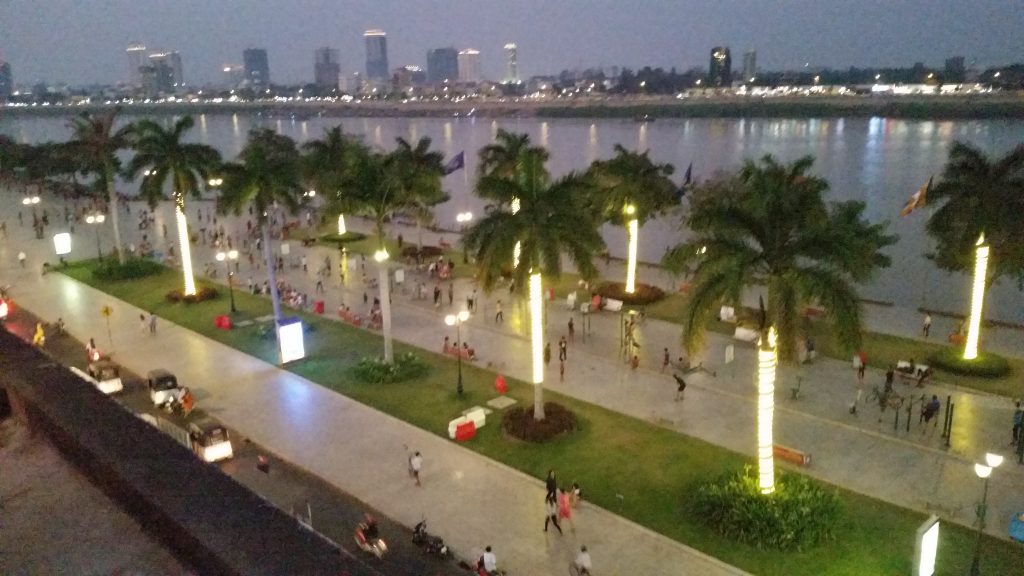
Just around the corner from abject poverty
I found Phnom Penh to be a lovely city and that is mainly down to the attitude of the people who live there. They just don’t seem to worry about how poor they might be in comparison to other people and they are very proud of their history and accomplishments. There’s lots to see too. The Royal Palace which houses the famous Silver Pagoda (though the Fresco outside stretching around the whole courtyard is more impressive), the incredibly moving and terrifying S-21 prison (now museum) that was one of many used by the Khmer Rouge to torture and execute over 2 million Cambodians in the mid to late 70s, the multiple night markets, the Killing Fields just outside of Phnom Penh and so much more. You’ll be hard pushed to get bored on a trip there.
S-21 alone is worth a visit to Phnom Penh. Enjoyable is not the word I would use to describe my experience, but it does remind me of an old axiom “Evil can only flourish when good people do nothing.”
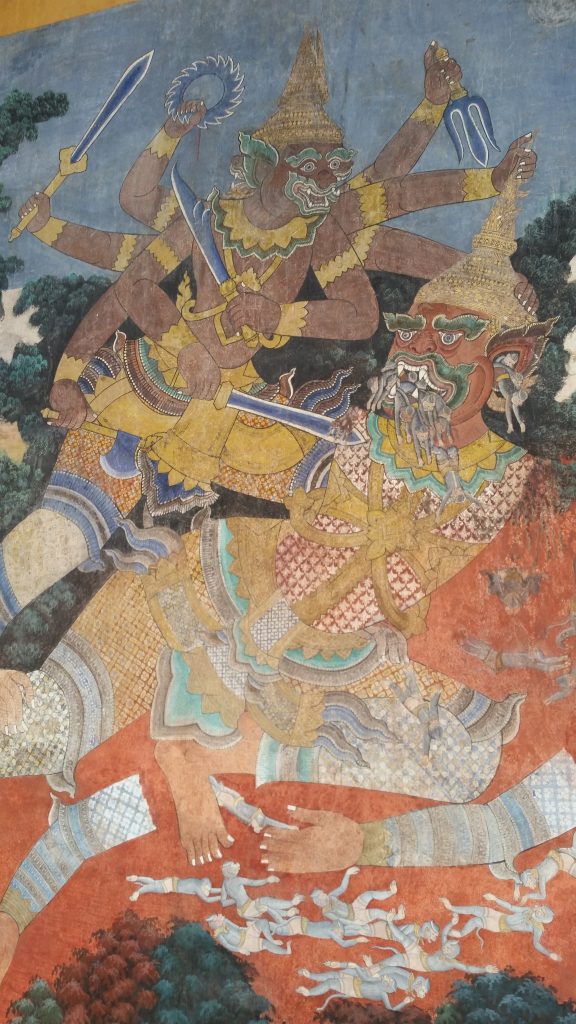
A small part of the Fresco outside the silver pagoda depicting a Cambodian poem of the Reamker. Look it up. It's interesting.
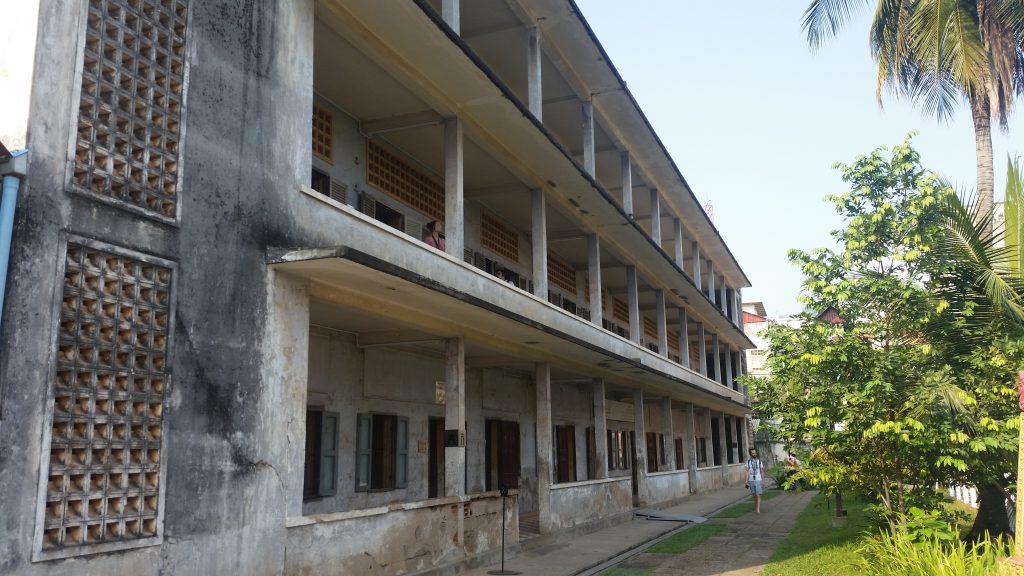
S21. A former school turned into a prison and torture chamber by the Khmer Rouge. A chilling reminder of what can happen when you promote ideology over humanity.
Siem Reap
So what of Siem Reap? Well it’s less built up then Phnom Penh, yet Phnom Penh feels more genuine. Large parts of Siem Reap have been constructed mainly as a base for tourists to visit the Angkor Wat Historical Park.
In that respect it does what it says on the tin. But compared to Phnom Penh, Siem Reap just feels a little too fake. There are large parts that are yet to be developed but you can see it happening over the next decade or so. The locals generally live away from the tourist sections of Pub Street, Soksan Road and surrounding areas and I don’t blame them. I wouldn’t want to live anywhere near those Benidorm-esque places either. Filled with drunks and package tours, Pub Street is just like any holiday strip in Ibiza or another party island. It’s fine for a couple of drinks (especially if you hit happy hour times) but unless you want to party until you throw up, I would always recommend eating somewhere else as all the prices are marked up by about $1.50-$2.00. Whilst that might not sound like much to the average earning westerner, if you’re on a long trip and need to watch your budget it can mean the difference between eating out and having a cracker back at your hotel or hostel.

The local Khmer hate it. I'm pretty sure many of the tourists do too.
Angkor Wat and surrounding temples
If you don’t visit this when going to Siem Reap, then what are you doing in Siem Reap? Located a few miles outside of the main city, the Angkor Wat Historical Park is a UNESCO World Heritage site for a reason; it’s pretty damn impressive. Each temple was built in different stages across several centuries and by different Khmer Kings so you get a mix of Buddhist and Hindu temples. One of the Kings even built temples to accommodate both religions resulting in architecture that has Hanuman and Vishnu alongside Buddha throughout the structures and inscriptions.

Angkor Wat at dawn...yes it's a total cliche as everyone who visits does this morning stop now.
At the time of writing a one day pass costs $37, a three day $62 and a week $72. Considering what you get for these prices, we thought they were amazingly good value and nearly all the money goes back into the maintenance, staff salaries and upkeep of the park. Yet surprisingly we still heard some people complaining that it was too expensive. They obviously haven’t tried to buy a ticket to an English Heritage attraction before. One woman was even cross with her tuk tuk driver because he hadn’t explained that she had to buy a ticket before entering the park.
Whilst the busiest section is the Angkor Wat temple itself with the famous towers...there is so much more to see in the complex and if you hire the right tuk tuk driver to take you around, you can see it all for a decent price (aim for a maximum of $20 a day if you can...and you can). We hired a great local guy for 3 days and we managed to see pretty much every temple and ruin there was to see, avoid the main tour crowds and visit many that are off the main routes so you end up walking around having the whole place to yourself. He also knew a lot about each temple so was able to be an unofficial tour guide at the start of each one. And yes...Ta Prohm is sadly now more famous for being the ‘Tomb Raider Temple’. Parts of the first film with Angelina Jolie were shot there in 2000. Good for tourism from the Cambodian perspective, even if the film itself wasn’t particularly great (though not as bad as the second one).
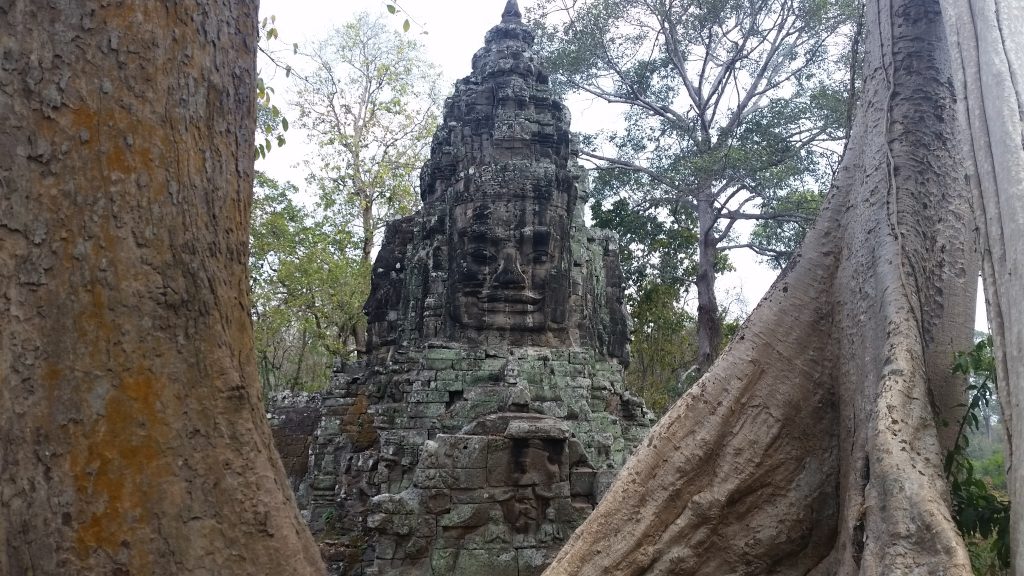
Smiling Buddha at the Victory Gate

Ta Phrom...or the "Tomb Raider" temple if you like the Lara Croft film...
Phnom Penh vs. Siem Reap?
Two different styles of city with different styles of living. I personally preferred Phnom Penh over Siem Reap, but Siem Reap does have the Angkor Wat complex going for it, which after all is why most people come to Siem Reap.
Next stop, Mondulkiri province and some volunteering in an elephant sanctuary.
Nervous Traveller Ratings
Phnom Penh
8/10 – Lots to see and do, great food and friendly people. More cosmopolitan than I expected with a large ex-pat community alongside the locals.
Siem Reap
6/10 – Does what it says on the tin, but is filled with touts, tours and drunk people. There is a nicer end where the locals go to stroll, chat and exercise along the river but the surrounding hotels and bars are more expensive.
Angkor Wat Historical Park
9/10 – Something everyone should see if they visit Cambodia.
Wedding Ring Status
Stuck on my finger – 35+ degree heat makes my digits swell up. Good for the bet, even if I do look like I have clown hands.
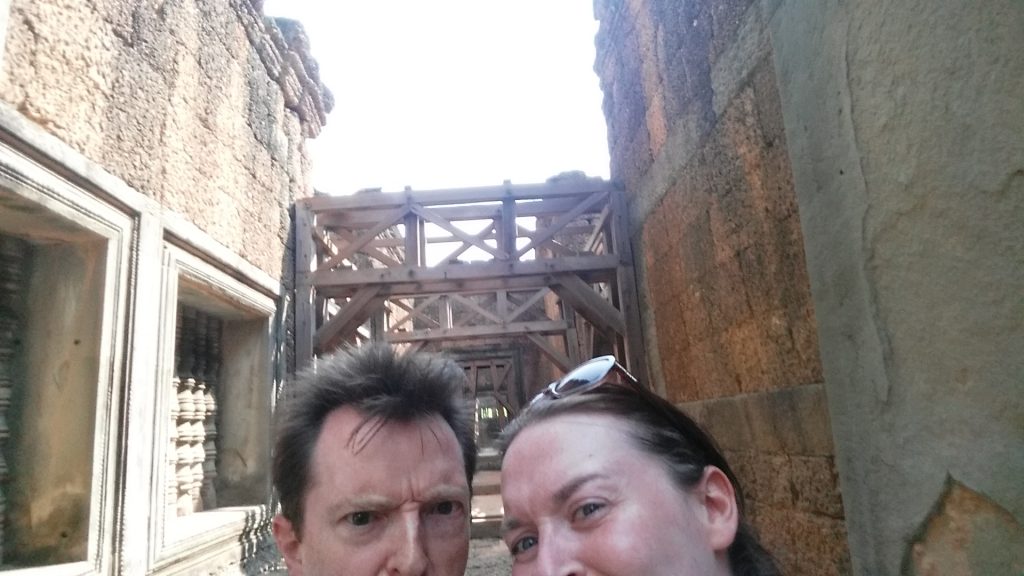
Artistic Selfie...okay I'm just shit with the camera.

